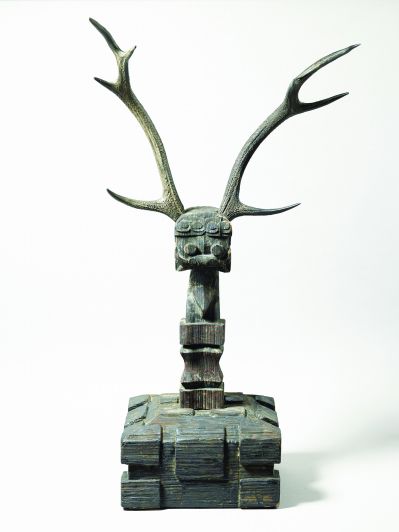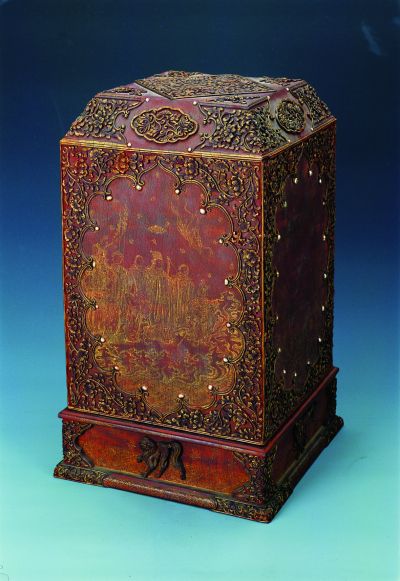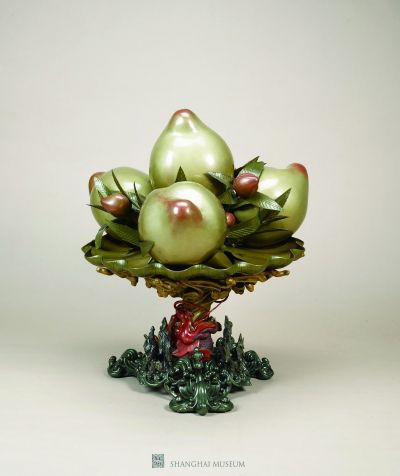Original title: Thousands of words and thousands of flowers, which are too numerous to be distinguished

Painted Lacquer Tomb Beast (Lacquerware), collected by Shanghai Museum during the Warring States Period

The top of the Buddhist relics letter (lacquer)
Collected by Zhejiang Provincial Museum of Northern Song Dynasty

Shen Zhenghao's painted fish peach plate (lacquer ware)
Collected by Shanghai Museum of Qing Dynasty
Our reporter Shi Xiaoqin
China is the birthplace of lacquer ware. Natural lacquer is a special product of China. It is called the king of lacquer in foreign countries. The so-called "white as snow, red as blood, and black as iron" is a beautiful portrayal of its color in various states. And wear resistance, corrosion resistance, the more beautiful the older is its unique excellent character. As a result, handicrafts made of raw lacquer can last for more than a thousand years without losing their luster. Together with ceramics and silk, they are called the three treasures of ancient Chinese traditional art, and enjoy worldwide reputation. The history of lacquer art was revealed by a lacquer bowl unearthed from the Neolithic site of Hemudu, Yuyao, Zhejiang Province, 7000 years ago.
A few days ago, the "Thousand Cultures and Ten Thousand Flowers - Chinese Lacquer Art Exhibition of Past Dynasties" was exhibited in Shanghai Museum. This exhibition systematically displayed more than 280 pieces of Chinese lacquer treasures from the Warring States Period to the 20th century, of which more than 270 pieces were collected by Shanghai Museum. This is also the first time that the Shanghai Museum systematically and completely displays the lacquerware in its collection. The last time such a special exhibition of lacquerware was held was 39 years ago. In the 1950s, the Shanghai Museum collected a large number of lacquerware at the beginning of its construction. On the basis of these collections, it coincided with the opportunity of archaeological excavation of a large number of lacquerware unearthed from such tombs as the Chu Tomb at Wangshan Sand Tomb in Jiangling, Hubei Province, the Western Han Tomb at 168 Fenghuang Mountain in Jiangling, and the Qin Tomb at Yunmeng Sleeping Tiger Land. In November 1979, the Shanghai Museum and the Hubei Museum jointly held the "Lacquerware Exhibition of Warring States Period, Qin and Han Dynasties Unearthed in Hubei Province", showing the lacquerware of Warring States Period, Qin and Han Dynasties unearthed in Jingchu area. This visual feast on lacquer art opened the door for people to understand Chinese lacquer ware, attracted more scholars to pay attention to lacquer ware, and promoted the national research on lacquer ware, especially early lacquer ware.
Different from the exhibition that focused on a certain region and a certain era in those years, this special exhibition is divided into six parts based on craftsmanship and chronological order. From the embryonic exploration of the Neolithic Age, to the flying of lacquer colors in the Warring States Period, Qin and Han Dynasties, to the blooming of a hundred flowers in the Song, Yuan, Ming and Qing Dynasties, it directly reflects the undulating and magnificent history of Chinese lacquer ware. The varieties include colored painting, plain painting, carved lacquer, mother of pearl, gold decoration, architectural lacquer, etc., covering most craft varieties in the two peak periods in the history of Chinese lacquer ware.
Lacquerware is made of wood, copper, bone, horn and other materials. It is painted with natural lacquer, which has the excellent characteristics of waterproof and moth proof. As early as in the Neolithic Age, our ancestors began to manufacture and use lacquer ware. The Zhu lacquer bowl unearthed from Hemudu Site, the jade inlaid lacquer cup unearthed from Liangzhu Site, and the lacquer bow unearthed from the Kuahuqiao Site all tell the long history of Chinese ancestors' use of lacquer. After the germination of the Neolithic Age and the continuous exploration of the Shang and Zhou Dynasties, the development of lacquer reached a prosperous period in the Warring States Period and the Qin and Han Dynasties, creating the first peak in the history of lacquer development. The etiquette, life and funeral articles of this period can all be made of lacquerware. Tens of thousands of lacquerware, mainly painted, were unearthed in tombs around the country. The first part of this exhibition, "Painted Paints Flying", mainly displays 38 pieces of painted lacquerware from the Warring States Period to the Qin and Han Dynasties. Painted lacquerware is a kind of lacquerware that appeared early and lasted for a long time. It began to sprout in the Neolithic Period, and reached its peak in the Warring States Period, Qin Dynasty and Han Dynasty after continuous exploration in the Xia, Shang and Zhou Dynasties. It has been produced in all dynasties since then. In the exhibition, there are a number of unearthed artifacts from tombs in this area allocated by the Shanghai Museum from the Jingzhou Museum in Hubei Province in 2008. In addition, some artifacts collected in recent years have different styles, which can reflect the universality of lacquer production in this period.
The Song, Yuan, Ming and Qing dynasties were the second peak period in the history of lacquer ware. There were many varieties and a considerable number, and most of them were works of art. This is also the focus of this exhibition. In order to introduce the lacquerware of the Song and Jin Dynasties, which was not known much to the society before, the Shanghai Museum specially borrowed and exhibited seven important unearthed lacquerware treasures collected by the Zhejiang Provincial Museum, Changzhou Museum, Fuzhou Museum and Datong Museum, some of which are top national treasures and have never left the region since they were unearthed.
In addition to the complicated patterns, fresh and elegant plain painting is also one of the enduring aesthetics in lacquer art. Simple plain lacquerware has been made in all dynasties, and has a long history of inheritance. Usually, only single or double color paint is used as decoration, reflecting the elegant aesthetic taste of the ancients. The second part of the exhibition, "Elegant Simple Painting", shows 24 pieces of plain lacquerware. Among the exhibits are daily necessities of the Song and Yuan Dynasties unearthed in Shanghai, as well as elegant art supplies such as the ancient zither, which are delicate, restrained and simple. During the Qianlong period of the Qing Dynasty, the chrysanthemum petal shaped vermilion lacquer bodiless ware was made with superb craftsmanship and ornate decoration, reflecting the aesthetic taste of the royal family.
Carving lacquer is an important part of lacquer craft. Unlike inlaying other materials, carved lacquer is an art of color and space. Carved lacquer is the lacquer that is painted to dozens or more layers on the upper layer of the body, and then carved with a knife. According to the different paint colors and carving methods, carved lacquer can be divided into carved rhinoceros, carved black, carved red, carved yellow, carved color, etc., which is the largest variety of lacquer handed down from generation to generation. The third part of the exhibition, "Carving Brocade and Carving Chinese", shows 96 pieces of carved lacquers from previous dynasties, which is the most important part of the exhibition. This part is displayed in the order of variety and age, trying to give the audience a more comprehensive understanding of the history of the development of carved lacquer.
Mother of pearl is the process of decorating the surface of lacquer ware with shells of conch and mussel. There are two types of thick mother of pearl and thin mother of pearl. During the Song and Yuan Dynasties, the process of mother of pearl was refined, and the pieces of mother of pearl became thinner, and many masterpieces appeared. Among the exhibits of "Qifei of mother of pearl" this time, "diamond shaped boxes with figures in black lacquered mother of pearl pavilions" and "round boxes with figures in black lacquered mother of pearl" in the Song and Yuan dynasties are all returned overseas cultural relics, rare and very precious in China. In the Qing Dynasty, mother of pearl kept improving. The thin pieces of mother of pearl were as thin as bees' wings and as fine as autumn hair. The technique of dotted snails was widely used, and some pieces were inlaid with gold flowers. Its composition and color matching simulated the interest of calligraphy and painting, and the brilliance could be appreciated along with the color.
The gold decoration craft of lacquer ware has a long history and a wide variety, which can be mainly divided into two categories: inlaying and tracing. The most popular gold and silver stripping process in the Tang Dynasty also falls into the inlay category. The most common lacquerware craft related to gold decoration is gold engraving and gold painting. The "Jinxiu Colorful Makeup" section displays 50 pieces of lacquer with various gold decorations and colors. Among the exhibits are the "vermilion lacquer pendant gold figures flower pattern diamond shaped toilet box" unearthed from the Song Tomb in the village front township of Wujin County, Changzhou City, Jiangsu Province, and the "letter of Buddhist relics with literature and gold painting" unearthed from the Huiguang Tower of the Northern Song Dynasty in Rui'an, Zhejiang Province, which respectively represent the highest level of gold and gold painting lacquerware in the Song Dynasty.
Fuzhou bodiless lacquerware is a craft category developed on the basis of inheriting the Chinese lacquer art tradition. It is light, bright, colorful and unique. Its founder was Shen Shao'an, Houguan County (today's Fuzhou City) of Fuzhou during the reign of Emperor Qianlong of the Qing Dynasty. He restored the ancient technique of making use of the body of Zhu, and skillfully matched the colors of lacquer painting, making the lacquer ware more colorful and ornamental. On this basis, descendants of the Shen family created thin material color painting techniques, and at the same time developed dozens of painting techniques, making Fuzhou bodiless lacquerware a distinctive craft variety. The last part of the exhibition, "Fujian Style Ruiguang", focuses on 21 bodiless painted lacquerware created by Shen Shao'an in Fuzhou in modern times, and one representative work of Xiamen lacquer line carving, which are representative varieties of lacquer craft in Fujian in the 20th century, with a strong sense of the times.
Xiushi Lu, written by Huang Cheng and annotated by Yang Ming in the Ming Dynasty, is the only existing ancient lacquer work in China. When Yang Ming rambled about the lacquerware craft of the past dynasties, he used the phrase "thousands of words and thousands of flowers, numerous and unsurpassed" to lament that the lacquerware craft developed to a great variety in the Ming Dynasty, which made people dizzy. After the Ming Dynasty, the development of lacquer art has never stopped. After thousands of years of accumulation and development, Chinese lacquerware has continuously enriched its categories, expanded and migrated its uses, and continuously inherited and innovated its craftsmanship, presenting a rich and diversified look. "Although lacquer ware is regarded as a 'small category' by many Chinese people, it is the quintessence of China, and thousands of lacquer wares have been unearthed in the tombs of the Warring States and Han Dynasties. Lacquerware of all previous dynasties in China can be daily necessities or high-end gifts, which is a real luxury for Chinese people." said Bao Yanli, the exhibition curator and researcher of Shanghai Museum.
It is understood that during the exhibition, the Shanghai Museum and the Chinese Society of Cultural Relics held the "International Academic Seminar on Ancient Chinese Lacquer" and the "2018 Annual Meeting of the Lacquer and Enamel Professional Committee of the Chinese Society of Cultural Relics", and cultural and museum experts from the British Museum, the Metropolitan Museum in New York, the National Museum in Tokyo, the Palace Museum in Beijing, Hunan Provincial Museum and other units, Scholars from Yale University, Tsinghua University and other institutions of higher learning as well as nearly 100 professionals from lacquer research institutions across the country attended the conference.
(Editor in charge: Lu Jing, He Yinghai)
Share to let more people see

































